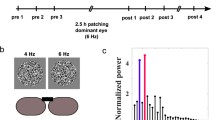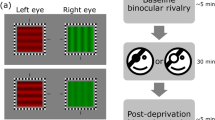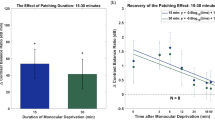Abstract
Monocular deprivation (MD) has much more rapid and severe effects on the ocular dominance of neurons in the primary visual cortex (V1) than does binocular deprivation1. This finding underlies the widely held hypothesis that the developmental plasticity of ocular dominance reflects competitive interactions for synaptic space between inputs from the two eyes2. According to this view, the relative levels of evoked activity in afferents representing the two eyes determine functional changes in response to altered visual experience. However, if the deprived eye of a monocularly deprived kitten is simply reopened, there is substantial physiological and behavioural recovery, leading to the suggestion that absolute activity levels, or some other non-competitive mechanisms, determine the degree of recovery from MD3,4,5,6,7. Here we provide evidence that correlated binocular input is essential for such recovery. Recovery is far less complete if the two eyes are misaligned after a period of MD. This is a powerful demonstration of the importance of cooperative, associative mechanisms in the developing visual cortex.




Similar content being viewed by others
References
Wiesel, T. N. & Hubel, D. H. Comparison of the effects of unilateral and bilateral eye closure on cortical unit responses in kittens. J. Neurophysiol. 28, 1029–1040 (1965).
Guillery, R. W. In The Making of the Nervous System (eds Parnevelas, J. G., Stern, C. J. & Sterling, R. V.) 356–379 (Oxford University Press, Oxford, 1988).
Mitchell, D. E. & Timney, B. in Handbook of Physiology Section I (The Nervous System) Vol. 3 Part 1 (Sensory Processes) (ed. Darian-Smith, I.) 507–555 (American Physiological Society, Bethesda, 1984).
Mitchell, D. E., Cynader, M. & Movshon, J. A. Recovery from the effects of monocular deprivation in kittens. J. Comp. Neurol. 176, 53–64 (1977).
Mitchell, D. E. The extent of visual recovery from early monocular or binocular visual deprivation in kittens. J. Physiol. (Lond.) 395, 639–660 (1988).
Giffin, F. & Mitchell, D. E. The rate of recovery of vision after early monocular deprivation in kittens. J. Physiol. (Lond.) 274, 511–553 (1978).
Mitchell, D. E. & Gingras, G. Visual recovery after monocular deprivation is driven by absolute rather than relative visually-evoked activity levels. Curr. Biol. 8, 1179–1182 (1998).
Hubel, D. H. & Wiesel, T. N. Binocular interaction in striate cortex of kittens reared with artificial squint. J. Neurophysiol. 28, 1041–1059 (1965).
Crair, M. C., Ruthazer, E. S., Gillespie, D. C. & Stryker, M. P. Relationship between the ocular dominance and orientation maps in visual cortex of monocularly deprived cats. Neuron 2, 307–318 (1997).
Sengpiel, F., Blakemore, C., Kind, P. C. & Harrad, R. Interocular suppression in the visual cortex of strabismic cats. J. Neurosci. 14, 6855–6871 (1994).
Kiorpes, L., Kiper, D. C., O'Keefe, L. P., Cavanaugh, J. R. & Movshon, J. A. Neuronal correlates of amblyopia in the visual cortex of macaque monkeys with experimental strabismus and anisometropia. J. Neurosci. 18, 6411–6424 (1998).
Murphy, K. M. & Mitchell, D. E. Bilateral amblyopia following a short period of reverse occlusion in kittens. Nature 323, 536–538 (1986).
Blakemore, C. & Van Sluyters, R. C. Reversal of the physiological effects of monocular deprivation in the kitten: further evidence for a sensitive period. J. Physiol. (Lond.) 237, 195–216 (1974).
Mitchell, D. E., Gingras, G. & Kind, P. C. Initial recovery of vision after early monocular deprivation in kittens is faster when both eyes are open. Proc. Natl Acad. Sci. USA 98, 11662–11667 (2001).
Malach, R. & Van Sluyters, R. C. Strabismus does not prevent recovery from monocular deprivation: a challenge for simple Hebbian models of synaptic modification. Vis. Neurosci. 3, 267–273 (1989).
Kirkwood, A., Lee, H.-K. & Bear, M. F. Co-regulation of long-term potentiation and experience-dependent synaptic plasticity in visual cortex by age and experience. Nature 375, 328–331 (1995).
Blakemore, C., Vital-Durand, F. & Garey, L. J. Recovery from monocular deprivation in the monkey. I. Recovery of physiological effects in the visual cortex. Proc. R. Soc. Lond. B 213, 399–423 (1981).
Blake, R., Crawford, M. L. & Hirsch, H. V. Consequences of alternating monocular deprivation on eye alignment and convergence in cats. Invest. Ophthalmol. 13, 121–126 (1974).
Movshon, J. A. Reversal of the behavioural effects of monocular deprivation in the kitten. J. Physiol. (Lond.) 261, 175–187 (1976).
Quick, M. W., Tigges, M., Gammon, J. A. & Boothe, R. G. Early abnormal visual experience induces strabismus in infant monkeys. Invest. Ophthalmol. Vis. Sci. 30, 1012–1017 (1989).
Bienenstock, E. L., Cooper, L. N. & Munro, P. W. Theory for the development of neuron selectivity: orientation specificity and binocular interaction in visual cortex. J. Neurosci. 2, 32–48 (1982).
Clothiaux, E. E., Bear, M. F. & Cooper, L. N. Synaptic plasticity in visual cortex: comparison of theory with experiment. J. Neurophysiol. 66, 1785–1804 (1991).
Rittenhouse, C. D., Shouval, H. Z., Paradiso, M. A. & Bear, M. F. Monocular deprivation induces homosynaptic long-term depression in visual cortex. Nature 397, 347–350 (1999).
Kind, P. C. Cortical plasticity: is it time for a change? Curr. Biol. 9, R640–R643 (1999).
Bonhoeffer, T. & Grinvald, A. in Brain Mapping: The Methods (eds Toga, A. W. & Mazziotta, J. C.) 55–97 (Academic, London, 1996).
Bonhoeffer, T., Kim, D. S., Malonek, D., Shoham, D. & Grinvald, A. Optical imaging of the layout of functional domains in area 17 and across the area 17/18 border in cat visual cortex. Eur. J. Neurosci. 7, 1973–1988 (1995).
Wörgötter, F. & Eysel, U. T. Quantitative determination of orientational and directional components in the response of visual cortical cells to moving stimuli. Biol. Cybern. 57, 349–355 (1987).
Acknowledgements
We thank M. Bear and H. Shouval for their helpful discussions, and I. Kehrer and M. Jones for technical assistance. This work was supported by the Wellcome Trust (P.C.K.), the Medical Research Council (C.B., F.S., B.A.), Max-Planck-Gesellschaft (T.B., F.S.), the Canadian Institutes of Health Research (D.E.M.) and the Oxford McDonnell Centre for Cognitive Neuroscience (C.B., B.A.).
Author information
Authors and Affiliations
Corresponding author
Ethics declarations
Competing interests
The authors declare that they have no competing financial interests
Rights and permissions
About this article
Cite this article
Kind, P., Mitchell, D., Ahmed, B. et al. Correlated binocular activity guides recovery from monocular deprivation. Nature 416, 430–433 (2002). https://doi.org/10.1038/416430a
Received:
Accepted:
Issue Date:
DOI: https://doi.org/10.1038/416430a
- Springer Nature Limited
This article is cited by
-
Functional neuronal circuits emerge in the absence of developmental activity
Nature Communications (2024)
-
Enriched binocular experience followed by sleep optimally restores binocular visual cortical responses in a mouse model of amblyopia
Communications Biology (2023)
-
The BCM theory of synapse modification at 30: interaction of theory with experiment
Nature Reviews Neuroscience (2012)
-
Structural traces of past experience in the cerebral cortex
Journal of Molecular Medicine (2010)
-
Development of the human cerebral cortex: Boulder Committee revisited
Nature Reviews Neuroscience (2008)





